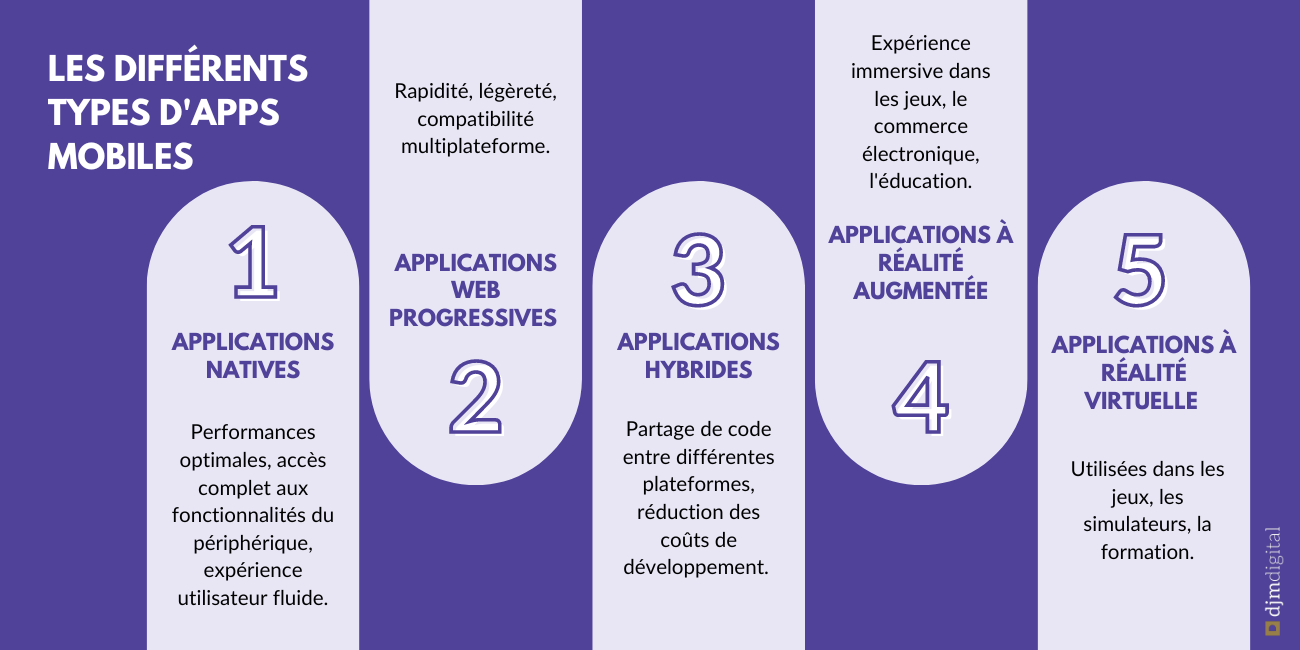Are you passionate about the world of mobile applications, but it’s not your area of expertise? Do you have a lot of questions and would like to benefit from the advice of our teams?
We’ve brought our experts together to answer the questions most frequently asked by our customers on this subject. Welcome to our FAQ dedicated to mobile applications!
1. What are the different types of mobile application?
There are several types of mobile application, each with its own specific features and functions. Here are the main categories:
Applications natives
Native applications are a special category in the world of mobile applications. They are designed with exceptional precision to integrate seamlessly into the ecosystem of the platform for which they are developed. In other words, they are tailored to deliver a seamless user experience in their host environment. The programming languages used in this case include Kotlin for Android and Swift for iOS.
Applications web progressives (PWA)
PWAs are websites that behave like native applications. They provide a user experience similar to that of a native application, without requiring installation from the app store. PWAs are accessible via a web browser and offer advantages in terms of speed, lightness and cross-platform compatibility. The languages used in this context include Angular for Android and reactJs for iOS.
Applications hybrides
Hybrid applications are applications developed using web technologies (HTML, CSS, JavaScript) and wrapped in a native container. This allows code to be shared between different platforms, reducing development costs. However, performance may be slightly lower than for native applications.
Augmented reality (AR) applications
These applications superimpose virtual elements onto the real world, offering an immersive experience. They are widely used in games, e-commerce and education.
Virtual reality (VR) applications
Unlike augmented reality, VR applications immerse users in a totally virtual environment. They are commonly used in games, simulators and training.

The choice of the type of application to develop will therefore depend on your business objectives, the target audience, the functionality required and the resources available.
2. What are the components of a mobile application?
A mobile application is made up of several elements that work together to provide a coherent and functional user experience. Here are the main components:
Front-end
This is the interface with which the user will interact. Its sole purpose is to display information and receive user interaction.
Back-end
The back-end is the invisible part of the application that manages data, user requests and application functionality. It is responsible for data processing and communication with the servers.
Database and API (Application Programming Interface)
The database stores the information needed for the application to function properly, such as user profiles, content and parameters. APIs enable different applications and systems to communicate with each other. They are essential for integrating third-party services and additional functionality into your application. In some cases, we prefer to externalise databases outside applications and use an API to communicate with them. This limits the resources drawn on by the applications, as the data retrieval operations from the database are calculated by a server to provide only what is needed on the application side.
Specific functionalities
Depending on the type of application, specific functionalities may be required. For example, a food delivery application uses geolocation to track the position of the delivery driver and estimate the delivery time.
Let’s take an e-commerce application where a user wants to buy their shopping basket; they click on the pay button (front-end), the application gathers the information needed for the payment transaction (back-end) and sends this information via a request to the payment API to make the payment. If it is validated, the API replies that everything is fine, and the information is sent back to the front-end to validate everything.
3. How do you effectively manage updates and maintenance for a mobile application?
Regular updates and maintenance are essential to ensure that the application runs smoothly and bugs are corrected. Here are some best practices for managing updates and maintenance:
Regular planning
Set up an update and maintenance schedule to keep up to date with the latest features and security patches.
Pre-deployment tests
Test updates on different platforms and devices to identify potential problems before they are rolled out.
User feedback
Take user feedback into account to make improvements and correct known problems.
Performance monitoring
Monitor application performance after each update to identify any effects on the user experience.
4. What are the key factors to take into account to ensure cross-platform compatibility for a mobile application?
Cross-platform compatibility is crucial to reaching a wider audience. Here are some key factors to consider to ensure compatibility:
Choice of framework
Opt for a development framework that allows code to be shared between different platforms, such as React Native or Flutter. At DJM, our developers use Xamarin on a daily basis.
Responsive design
Design a user interface that adapts naturally to different screen sizes and orientations. Your app needs to adapt to provide the best possible experience for every user. Also think about the fluidity of the flow of information in your application. For example, in an email app, the “inbox” section should react dynamically according to its content. When messages arrive, the interface should display these new entries intuitively. Similarly, if the inbox is empty, a clear presentation inviting action should be proposed. Adopting this responsive approach ensures that your application remains engaging and functional, regardless of how users interact with it.
Tests multiplateformes
Perform in-depth tests on different platforms and devices to identify compatibility issues.
Management of platform-specific functionalities
Make sure that the features specific to each platform are correctly implemented and offer a seamless experience.
5. How can the security and confidentiality of user data in a mobile application be guaranteed?
Data security and confidentiality are essential aspects in gaining the trust of users. Here are some steps you can take to ensure that your data is adequately protected:
Data encryption
Use encryption to secure sensitive information stored in the application and on servers.
Secure authentication
Set up robust authentication to protect access to user accounts.
Security updates
Keep the application up to date with the latest security patches to prevent known vulnerabilities.
Protection against piracy
Apply security measures, such as data encryption and authentication mechanisms, to prevent the application from being hacked and malicious code from being injected.
Privacy policy
Draw up a clear privacy policy to inform users about how their data is collected, stored and used.
By adopting these best practices, you will increase the security of the application and the confidence of users.
To find out more…
In 2022, our experts had the pleasure of taking part in Sortlist’s “Beyond Marketing” podcast, recorded at the Grand Poste in Liège. The subject? Application development.




